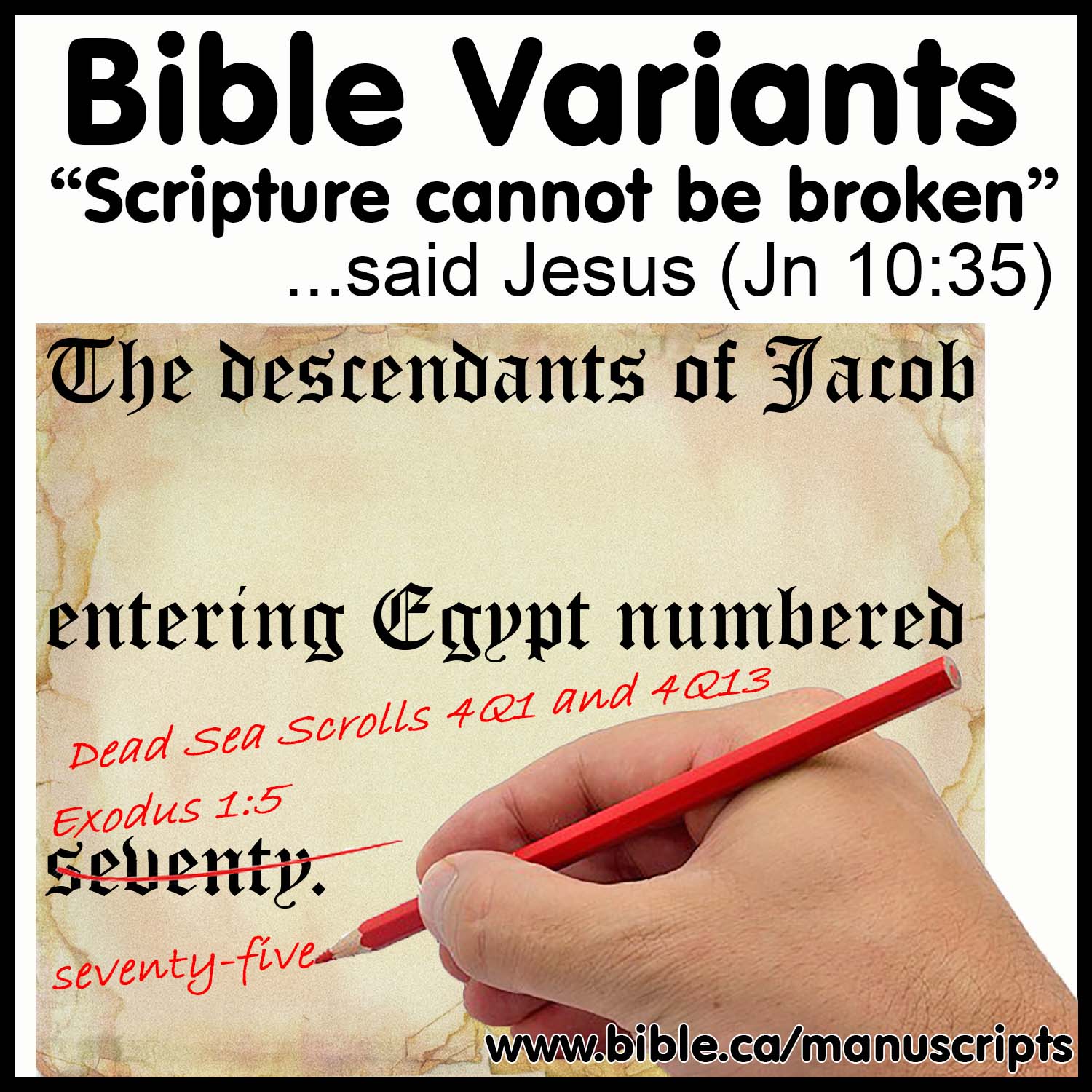Creation in 5500 BC
Five Books of the Chronography
221 AD
The Hebrew MT and Septuagint Chronology numbers were the same.
70 weeks of Daniel 9 end in 33 AD at resurrection
|
|
|
|
Julius Africanus Sextus used the Hebrew Masoretic text in Jerusalem to calculate an age of the earth that was identical to the Septuagint. |
“For the Jews, deriving their origin from them as descendants of Abraham, having been taught a modest mind, and one such as becomes men, together with the truth by the spirit of Moses, have handed down to us, by their extant Hebrew histories, [ie. the Masoretic Text, MT] the number of 5500 years as the period up to the advent of the Word of salvation, that was announced to the world in the time of the sway of the Cæsars.” (Julius Africanus Sextus, Five Books of the Chronography, Fragment 1, 221 AD) |
|
|
|
Introduction:
1. Julius Africanus Sextus grew up on Jerusalem and was highly educated.
a. Julius Africanus Sextus created a detailed chronology from Creation to the year 221 AD.
b. His chronological numbers are an exact match to the LXX yet we know he was following the Hebrew Masoretic text because he does not include Cainan.
c. Cainan is found in the New Testament and the LXX Tanakh but not in the Masoretic.
d. This proves that as late as 221 AD the accepted numbers in the Hebrew text had not yet been corrupted and changed by the Jews as witnessed in the modern Masoretic text.
2. In 221 AD, Julius Africanus Sextus was using the Hebrew Masoretic text whose numbers agreed with the longer chronological numbers in the Septuagint exactly and not the shorter numbers in today’s Masoretic Text.
a. He told us he was using a Hebrew not Greek text.
b. His chronology did not include Cainan, which the LXX does include and the modern MT does not.
c. Julius Africanus Sextus calculated creation in 5500 BC.
d. Julius Africanus Sextus also correctly interpreted the end of the 70 weeks of Daniel 9 to happen at the resurrection of Christ.
e. The Hebrew text that Julius Africanus Sextus had before him are identical to the LXX and divergent from the modern Masoretic MT.
f. The fact that Julius Africanus Sextus was using a HEBREW text and not the Greek Septuagint (LXX) is powerful evidence that at this point in history, the numbers in the MT were identical to the LXX.
g. This shows that the corruption of the chronological numbers in the MT text was either very recent in the past (150 AD) or that it was soon to happen.
h. It is also possible that Julius Africanus Sextus produced this chronology from one of the uncorrupted original Hebrew (proto-Masoretic) texts in protest to the new revision by the Jewish corrupters in an effort to counter Christianity.
i. “Fragment 15 reads: “. . . and from their remaining Hebrew histories, they [the Jews] have handed down a period of 5500 years up to the advent of the Word of salvation [Christ] . . .” (Wallraff, Roberto, and Pinggera 2007, 25). Africanus resided in Israel most of his life, and had knowledge of Greek, Latin, and Hebrew. He even refers to Hebrew as “our” way of speaking (Wallraff, Roberto, and Pinggera 2007, xv–xvi). Thus, Africanus would have been able to compare manuscripts of the LXX to those available to him in Hebrew. It is interesting that Africanus never mentions the numerical divergences between the (proto) MT and LXX in Genesis 5 and 11. Perhaps this is evidence that his particular Hebrew texts contained the higher begetting ages. (Henry Smith, Methuselah, 2017)
3. It is utterly astounding and fascinating that the interpretive chronological errors cancel each other out to present day knowledge so that the creation date (5500 BC) of Julius Africanus Sextus was almost exactly correct to modern scholarship standards.
4. About Julius Africanus Sextus:
a. “Julius was born in Jerusalem and was well educated. In his younger years he traveled extensively, visiting various biblical sites. For a time he lived in Emmaus and eventually went as an ambassador from that city to Rome. He so impressed Emperor Alexander Severus with his learning that the emperor appointed him to build the library at the Pantheon.” (Who’s Who in Christian History, W. R. Godfrey, Julius Africanus Sextus, p918, 1992 AD)
b. “Sextus Julius Africanus, a native of Aelia Capitolina (Jerusalem), was an official under Septimius Severus. We know that Alexander Severus charged him with organizing a library at Rome in the Pantheon. He was at Alexandria at the school of Heracles and made the acquaintance of Origen. We find him later in Palestine, at Nicopolis, where he died around 240 AD. There are only fragments surviving of the two principal works composed by him: the Chronicles, starting from the creation of the world up to 221 AD, put side by side in a synchronic form biblical dates and events with the events of Greek and Roman history. Julius Africanus, who compiled the work with probably millenarist intentions, fixed the duration of the world at 6,000 years and the birth of Christ at the year 5,500.” (Encyclopedia of Ancient Christianity, Julius Africanus, Volume 2, Page 488, 2014 AD)
c. “His chief work was a ‘History of the World’ (Χρονογραφίαι) to AD 217 in five Books, of which fragments are preserved in Eusebius’ ‘Chronicle’, George Syncellus, and other writers. He held that the world would last for 6,000 years from the Creation and that the Birth of Christ, which he antedated in relation to his own times by three years, took place in the year 5500. His ‘Embroidered Girdles’ (Κεστοί) is an encyclopaedic work in 24 Books, dedicated to Alexander Severus, on natural history, medicine, military science, magic, and miscellaneous subjects. This, too, survives only in fragments. He was also the author of two letters, one to Origen contesting the genuineness of the story of Susanna and the other to a certain Aristides on the genealogies of Christ in Matthew and Luke, both epistles showing good critical powers.” (The Oxford Dictionary of the Christian Church, Julius Africanus Sextus, 2005 AD)
I. In 221 AD, Julius Africanus Sextus chronology used the Hebrew Masoretic text of the day:
1. Here is the key statement that shows Julius Africanus Sextus was using the MT not the LXX for his chronological numbers:
a. “For the Jews, deriving their origin from them as descendants of Abraham, having been taught a modest mind, and one such as becomes men, together with the truth by the spirit of Moses, have handed down to us, by their extant Hebrew histories, the number of 5500 years as the period up to the advent of the Word of salvation, that was announced to the world in the time of the sway of the Cæsars. (Julius Africanus Sextus, Five Books of the Chronography, Fragment 1, 221 AD)
2. What does “extant Hebrew histories” mean?
a. “Extant”: This means the current chronologies of the Hebrews available to Julius Africanus Sextus in 221 AD either by oral tradition, secular records or the Hebrew Bible.
b. “Hebrew history”: We don’t know if “Hebrew” is referencing the TYPE of history, i.e., the history of the Hebrews; or, if it referring to the kind of text in which it appears, i.e. a Hebrew text either secular or Tanakh.
c. It is important to keep in mind that two very widely read secular Jewish documents, the book of Jubilees (170 BC) and Seder Olam Rabbah (160 AD) date the age of the earth to 3761 BC.
d. Therefore since the chronological numbers Julius Africanus Sextus used are at great variance with the opinions of Jews of his day, the only possible option is that he was referring to the Hebrew Tanakh. Remember, we know he did not get his numbers from the LXX or else he would have included Cainan, which is missing from the Hebrew text altogether.
II. The Genesis 5 Chronology according to Julius Africanus Sextus
1. The Genesis 5 Chronology according to Julius Africanus Sextus is an exact match for the Septuagint
2. Fragment 3: “Adam, when 230 years old, begets Seth; and after living other 700 years he died, that is, a second death. Seth, when 205 years old, begat Enos; from Adam therefore to the birth of Enos there are 435 years in all. Enos, when 190 years old, begets Cainan. Cainan again, when 170 years old, begets Malaleel; And Malaleel, when 165 years old; begets, Jared; And Jared, when 162 years old, begets Enoch; And Enoch, when 165 years old, begets Mathusala; and having pleased God, after a life of other 200 years, he was not found. Mathusala, when 187 years old, begat Lamech. Lamech, when 188 years old, begets Noe.” (Julius Africanus Sextus, Five Books of the Chronography, Fragment 3, 221 AD)
|
Genesis 5 Chronology Julius Africanus Sextus is in perfect agreement with the LXX in 221 AD |
||||||
|
|
Julius Africanus Sextus, fragment 2, 221 AD |
Septuagint LXX Greek Text |
||||
|
Man |
Age at Son's Birth |
Remaining Years |
Age at Death |
Age at Son's Birth |
Remaining Years |
Age at Death |
|
Adam |
230 |
700 |
- |
230 |
700 |
930 |
|
Seth |
205 |
- |
- |
205 |
707 |
912 |
|
Enosh |
190 |
- |
- |
190 |
715 |
905 |
|
Cainan |
170 |
- |
- |
170 |
740 |
910 |
|
Mahalalel |
165 |
- |
- |
165 |
730 |
895 |
|
Jared |
162 |
- |
- |
162 |
800 |
962 |
|
Enoch |
165 |
- |
365 |
165 |
200 |
365 |
|
Methuselah |
187 |
- |
- |
187 |
782 |
969 |
|
Lamech |
188 |
- |
- |
188 |
565 |
753 |
|
Noah |
- |
- |
- |
500 |
450 |
950 |
III. The Genesis 11 Chronology according to Julius Africanus Sextus:
1. The Genesis 11 Chronology according to Julius Africanus Sextus is an exact match for the Septuagint
2. Fragment 6,7: “And after the flood, Sem begat Arphaxad. Arphaxad, when 135 years old, begets Sala in the year 2397. Sala, when 130 years old, begets Heber in the year 2527. Heber, when 134 years old, begets Phalec in the year 2661, so called because the earth was divided in his days. Phalec, when 130 years old, begot Ragan, and after living other 209 years died. … In the year of the world 3277, Abraham entered the promised land of Canaan.” (Julius Africanus Sextus, Five Books of the Chronography, Fragments 6,7, 221 AD)
|
Genesis 11 Chronology Julius Africanus Sextus is in perfect agreement with the LXX in 221 AD |
||||
|
Person |
Julius Africanus Sextus, frag. 6,7, 221 AD |
Septuagint LXX Greek Text |
||
|
|
Age at Birth of son |
Birth of son After Creation |
Year at Birth |
Birth of son After creation |
|
Shem |
- |
|
100 |
|
|
Arphaxad |
135 |
2397 AC |
135 |
2393 AC |
|
Cainan |
Skipped |
skipped |
130 |
|
|
Shelah (Sala) |
130 |
2527 |
130 |
2523 AC |
|
Eber (Heber) |
134 |
2661 |
134 |
2653 AC |
|
Peleg (Phalec) |
130 |
|
130 |
|
|
Reu (Ragan) |
|
|
132 |
|
|
Serug |
|
|
130 |
|
|
Nahor |
|
|
79 |
|
|
Terah |
|
3277 |
3258 AC |
|
|
Abraham |
|
|
70 |
|
IV. The Genesis 5,11 Chronology according to Julius Africanus Sextus vs. LXX vs. MT:
1. The Hebrew text that Julius Africanus Sextus had before him are identical to the LXX and divergent from the modern Masoretic MT.
2. The fact that Julius Africanus Sextus was using a HEBREW text and not the Greek Septuagint (LXX) is powerful evidence that at this point in history, the numbers in the MT were identical to the LXX.
3. This shows that the corruption of the chronological numbers in the MT text was either very recent in the past (150 AD) or that it was soon to happen.
4. It is also possible that Julius Africanus Sextus produced this chronology from one of the uncorrupted original Hebrew (proto-Masoretic) texts in protest to the new revision by the Jewish corrupters in an effort to counter Christianity.
|
Julius Africanus’ dates match the LXX against the MT (221 AD) |
|||
|
|
Julius Africanus 221 AD |
Septuagint LXX |
Masoretic MT |
|
Creation to birth of Christ 1 BC (f18) |
5500 years (-59 error: Terah 75 when Abraham born = 60 years error) |
5553 years (5554 - 1 BC) |
4173 years (4174-1 BC) |
|
Creation to Cross 33 AD (f18) |
5531 years (-62 error) |
5521 years (5554 BC - 33 AD) |
4141 years (4174 BC - 33 AD) |
|
Creation to Rome (f17) |
5472 years (-57 error) |
5523 years (5554-31 BC) |
4143 years (4174-31 BC) |
|
Creation to death of Joseph in 1806 BC (f11) |
3563 years (-191 error, skips Cainan = 130 years, Terah 75 when Abraham born = 60 years) |
3748 (5554-1806 BC) |
2288 years (4174-1886 BC) |
|
Creation to Abraham leaves Haran in 2091 BC (f8) |
3277 years (-192 error, skips Cainan = 130 years, Terah 75 when Abraham born = 60 years) |
3463 years (5554 - 2091 BC) |
2083 years (4174 - 2091 BC) |
|
Flood to Abraham leaves Haran in 2091 BC (f8) |
1015 years (-132 error, skips Cainan = 130 years) |
1207 years (3298 - 2091 BC) |
427 years (2518 - 2091 BC) |
|
Exodus to Cyrus’ decree (f13) 1446 - 539 BC = 907 yrs |
1237 years (+330 error) |
1446 - 539 BC = 907 yrs |
1446 - 539 BC = 907 yrs |
|
Conquest to David’s first year as king at Hebron (f13) 1406-1010 BC = 396 yrs |
635 years (+239 error) |
1406-1010 BC = 396 yrs |
1406-1010 BC = 396 yrs |
|
Period of the Judges (f13) 1350 - 1010 BC = 340 yrs |
490 years (+150 error) |
1350 - 1010 BC = 340 yrs |
1350 - 1010 BC = 340 yrs |
|
Period of kings: Saul to Zedekiah (f13) 1052-577 BC = 475 yrs |
490 years (+15 error) |
1052-577 BC = 475 yrs |
1052-577 BC = 475 yrs |
|
Persia to cross: (120 + 442 BC + 33) Year 120 of Persia= 419 BC (f16-18) |
595 years (+23 error) |
572 years (539 BC - 33 AD) |
- |
|
Daniel’s 70 weeks1 (f16-18) |
442 BC – 33 AD = 475 years (-15 error)
|
Ezra 7:8, 7th year of Artaxerxes (458 BC - 33 AD = 490 solar years. |
- |
|
Nehemiah begins in 20th year of Artaxerxes = 442 BC to cross 33 AD. (f16-18) |
442 BC - 33 AD = 475 years (-3 error) |
20th year of Artaxerxes is 445 BC (478 years = 445 BC to 33 AD) |
- |
|
1. Julius Africanus correctly understood that the 70 weeks of Daniel end at the cross (33 AD). His starting point was wrong. He converted the 70 weeks (490 years) of Dan 9:27, from 490 “Hebrew years” into 475 “solar years”. He viewed the prophecy based upon a lunar month being 28.5 days etc. So he was looking for 475 solar years instead of the correct 490 solar years. This led Africanus to chose the wrong starting point as the 20th year of Artaxerxes (445 BC) when Nehemiah went to Jerusalem, instead of the correct 7th year based upon Ezra 7:8 (458 BC). Even though he started with Nehemiah, his chronological numbers from Nehemiah (445 BC) are very close to the correct ones. |
|||
V. Errors in Julius Africanus’ chronology compared to LXX cancel out perfectly to zero
1. The errors in the chronology of Julius Africanus Sextus were not because the Bible text was wrong, but because he wrongly interpreted periods of world history in error that are not revealed in the Bible directly.
2. What is utterly astounding and fascinating is that the creation date (5500 BC) of Julius Africanus Sextus was almost exactly correct to modern scholarship standards.
3. In other words, in some periods he had to much time and in others, he had too short a time, but in the end, his final number was essentially correct to the best modern research today.
4. Julius Africanus calculated the age of the earth at 5500 BC but when you factor in his 60 year error of the age of Terah when Abraham was born, his number is an exact match. Although he did make several errors in each “area” of his chronology, the sum actually cancel each other out so that the difference nets to a zero year difference to our understanding in 2017 AD. This is quite remarkable. What this means is that his date for the age of the earth (AC date) was exactly correct and his calculation for the birth (1 BC) and crucifixion of Christ in 33 AD are correct.
|
Julius Africanus |
Modern scholarship |
Julius Africanus’ Error |
|
Shem firstborn of Noah in 500 BC |
Shem second-born of Noah in 502 BC |
2 |
|
Skips Cainan |
LXX Includes Cainan (130 years) |
-130 years |
|
Terah 75 years old when Abraham born |
Acts 7:5 says Abraham was born when Terah was 130 years old |
-60 years |
|
Period of the Judges: 490 years |
1350 - 1010 BC = 340 yrs |
+150 years |
|
Period of kings: 490 years |
1052-577 BC = 475 yrs |
+15 years |
|
Persia to cross: 595 years (120 + 442 BC + 33 AD) |
595 years |
+23 years |
|
Net error from Creation to birth of Christ: |
0 difference |
|
VI. Other fragments of Julius Africanus’ chronology:
|
Moses to Cyrus, Judges, kings, captivity, Cyrus: |
“From the exodus of Moses up to Cyrus, who reigned after the captivity, are 1237 years. For the remaining years of Moses are 40. The years of Jesus [Joshua], who led the people after him, are 25; those of the elders, who were judges after Jesus, are 30; those of the judges, whose history is given in the book of Judges, are 490; those of the priests Eli and Samuel are 90; those of the successive kings of the Hebrews are 490. Then come the 70 years of the captivity, the last year of which was the first year of the reign of Cyrus, as we have already said. 6. And from Moses, then, to the first Olympiad there are 1020 years, as to the first year of the 55th Olympiad from the same are 1237, in which enumeration the reckoning of the Greeks coincides with us.” (Julius Africanus Sextus, Five Books of the Chronography, Book 3, Fragment 13, 221 AD) |
|
Creation to Rome (31 BC): |
“Thus is made up the whole period from the foundation of the Macedonian empire to its subversion in the time of the Ptolemies, and under Cleopatra, the last of these, the date of which event is the 11th year of the monarchy and empire of the Romans, and the 4th year of the 187th Olympiad. Altogether, from Adam 5472 years are reckoned. (Julius Africanus Sextus, Five Books of the Chronography, Fragment 17, 221 AD) |
|
Creation to death of Joseph: (1806 BC) |
“From Adam, therefore, to the death of Joseph, according to this book, are 23 generations, and 3563 years.” (Julius Africanus Sextus, Five Books of the Chronography, Fragments 11, 221 AD) |
|
Creation and Flood to Abraham: |
“From this rises the appellation of the Hebrews. For the word Hebrews is interpreted to mean those who migrate across, viz., who crossed the Euphrates with Abraham; and it is not derived, as some think, from the fore-mentioned Heber. From the flood and Noe, therefore, to Abraham’s entrance into the promised land, there are in all 1015 years; and from Adam, in 20 generations 3277 years.” (Julius Africanus Sextus, Five Books of the Chronography, Fragment 8, 221 AD) |
|
Creation to Birth of Christ: |
“For the Jews, deriving their origin from them as descendants of Abraham, having been taught a modest mind, and one such as becomes men, together with the truth by the spirit of Moses, have handed down to us, by their extant Hebrew histories, the number of 5500 years as the period up to the advent of the Word of salvation, that was announced to the world in the time of the sway of the Cæsars. (Julius Africanus Sextus, Five Books of the Chronography, Fragment 1, 221 AD) |
|
Creation to cross: |
“From Artaxerxes, again, in whose time the command went forth that Jerusalem should be built, there are 70 weeks. These matters, however, we have discussed by themselves, and with greater exactness, in our book On the Weeks and this Prophecy. But I am amazed that the Jews deny that the Lord has yet come, and that the followers of Marcion refuse to admit that His coming was predicted in the prophecies when the Scriptures display the matter so openly to our view. And after something else: The period, then, to the advent [cross] of the Lord from Adam and the creation is 5531 years, from which epoch to the 250th Olympiad there are 192 years, as has been shown above.” (Julius Africanus Sextus, Five Books of the Chronography, Fragment 18, 221 AD) |
|
“On the Deluge: God decreed to destroy the whole race of the living by a flood, having threatened that men should not survive beyond 120 years. Nor let it be deemed a matter of difficulty, because some lived afterwards a longer period than that. For the space of time meant was 100 years up to the flood in the case of the sinners of that time; for they were 20 years old. God instructed Noe, who pleased him on account of his righteousness, to prepare an ark; and when it was finished, there entered it Noe himself and his sons, his wife and his daughters-in-law, and firstlings of every living creature, with a view to the duration of the race. And Noe was 600 years old when the flood came on. And when the water abated, the ark settled on the mountains of Ararat, which we know to be in Parthia; but some say that they are at Celænæ6 of Phrygia, and I have seen both places. And the flood prevailed for a year, and then the earth became dry. And they came out of the ark in pairs, as may be found, and not in the manner in which they had entered, viz., distinguished according to their species, and were blessed by God. And each of these things in dicates something useful to us.” (Julius Africanus Sextus, Five Books of the Chronography, Book V, Fragment 16, 221 AD) |
|
|
Dates based upon Olymdiads |
1. Year 4 of 83rd Olympiad = [776 BC - (83*4) + 4] = 448 BC 2. Year 2 of 102nd Olympiad [776 BC - (102*4) + 2] = 370 BC |
VII. The 70 weeks of Daniel reinterpreted Post 70 AD: the abomination of desolation without a messiah:
1. Julius Africanus Sextus interpretation of the 70 weeks of Daniel 9:24:
a. The start was the 120th year of the Persian empire was equal to the 20th year of Artaxerxes which he thought was 445 BC.
b. He converted the 490 “Jewish years of the lunar calendar” into 475 Julian years.
c. xxx
2. Julius Africanus Sextus 70 years begins in the 20th year of Artaxerxes:
a. “As to His works severally, and His cures effected upon body and soul, and the mysteries of His doctrine, and the resurrection from the dead, these have been most authoritatively set forth by His disciples and apostles before us. On the whole world there pressed a most fearful darkness; and the rocks were rent by an earthquake, and many places in Judea and other districts were thrown down. This darkness Thallus, in the third book of his History, calls, as appears to me without reason, an eclipse of the sun. For the Hebrews celebrate the passover on the 14th day according to the moon, and the passion of our Saviour falls on the day before the passover; but an eclipse of the sun takes place only when the moon comes under the sun. And it cannot happen at any other time but in the interval between the first day of the new moon and the last of the old, that is, at their junction: how then should an eclipse be supposed to happen when the moon is almost diametrically opposite the sun? Let that opinion pass however; let it carry the majority with it; and let this portent of the world be deemed an eclipse of the sun, like others a portent only to the eye. Phlegon records that, in the time of Tiberius Cæsar, at full moon, there was a full eclipse of the sun from the sixth hour to the ninth—manifestly that one of which we speak. But what has an eclipse in common with an earthquake, the rending rocks, and the resurrection of the dead, and so great a perturbation throughout the universe? Surely no such event as this is recorded for a long period. But it was a darkness induced by God, because the Lord happened then to suffer. And calculation makes out that the period of 70 weeks, as noted in Daniel, is completed at this time. From Artaxerxes, moreover, 70 weeks are reckoned up to the time of Christ, according to the numeration of the Jews. For from Nehemiah, who was sent by Artaxerxes to people Jerusalem, about the 120th year of the Persian empire [actual 419 BC, his 445 BC], and in the 20th year of Artaxerxes himself [Actual 445 BC], and the 4th year of the 83d Olympiad [448 BC], up to this time, which was the 2d year of the 102d Olympiad [370 BC], and the 16th year of the reign of Tiberius Cæsar [30 AD], there are given 475 years, which make 490 Hebrew years, since they measure the years by the lunar month of 29 1/2 days, as may easily be explained, the annual period according to the sun consisting of 365 1/4 days, while the lunar period of 12 months has 11 1 /4 days less. For which reason the Greeks and the Jews insert three intercalary months every eight years. For 8 times 11 1 /4 days make 3 months. The 475 years, therefore, contain 59 periods of 8 years and three months over: thus, the three intercalary months for every 8 years being added, we get 15 years, and these together with the 475 years make 70 weeks. Let no one now think us unskilled in the calculations of astronomy, when we fix without further ado the number of days at 365 1/4. For it is not in ignorance of the truth, but rather by reason of exact study, that we have stated our opinion so shortly. But let what follows also be presented as in outline to those who endeavour to inquire minutely into all things.” (Julius Africanus Sextus, Five Books of the Chronography, Fragment 18, 221 AD)
3. “On the Seventy Weeks of Daniel: This passage, therefore, as it stands thus, touches on many marvellous things. At present, however, I shall speak only of those things in it which bear upon chronology, and matters connected therewith. That the passage speaks then of the advent of Christ, who was to manifest Himself after seventy weeks, is evident. For in the Saviour’s time, or from Him, are transgressions abrogated, and sins brought to an end. And through remission, moreover, are iniquities, along with offences, blotted out by expiation; and an everlasting righteousness is preached, different from that which is by the law, and visions and prophecies (are) until John, and the Most Holy is anointed. For before the advent of the Saviour these things were not yet, and were therefore only looked for. And the beginning of the numbers, that is, of the seventy weeks which make up 490 years, the angel instructs us to take from the going forth of the commandment to answer and to build Jerusalem. And this happened in the twentieth year of the reign of Artaxerxes king of Persia. For Nehemiah his cup-bearer besought him, and received the answer that Jerusalem should be built. And the word went forth commanding these things; for up to that time the city was desolate. For when Cyrus, after the seventy years’ captivity, gave free permission to all to return who desired it, some of them under the leadership of Jesus she high priest and Zorobabel, and others after these under the leadership of Esdra, returned, but were prevented at first from building the temple, and from surrounding the city with a wall, on the plea that that had not been commanded. 2. It remained in this position, accordingly, until Nehemiah and the reign of Artaxerxes, and the 115th year of the sovereignty of the Persians. And from the capture of Jerusalem that makes 185 years. And at that time King Artaxerxes gave order that the city should be built; and Nehemiah being despatched, superintended the work, and the street and the surrounding wall were built, as had been prophesied. And reckoning from that point, we make up seventy weeks to the time of Christ. For if we begin to reckon from any other point, and not from this, the periods will not correspond, and very many odd results will meet us. For if we begin the calculation of the seventy weeks from Cyrus and the first restoration, there will be upwards of one hundred years too many, and there will be a larger number if we begin from the day on which the angel gave the prophecy to Daniel, and a much larger number still if we begin from the commencement of the captivity. For we find the sovereignty of the Persians comprising a period of 230 years, and that of the Macedonians extending over 370 years, and from that to the 16th year of Tiberius Cæsar is a period of about 60 years. 3. It is by calculating from Artaxerxes, therefore, up to the time of Christ that the seventy weeks are made up, according to the numeration of the Jews. For from Nehemiah, who was despatched by Artaxerxes to build Jerusalem in the 115th year of the Persian empire, and the 4th year of the 83d Olympiad, and the 20th year of the reign of Artaxerxes himself, up to ibis date, which was the second year of the 202d Olympiad, and the 16th year of the reign of Tiberius Cæsar, there are reckoned 475 years, which make 490 according to the Hebrew numeration, as they measure the years by the course of the moon; so that, as is easy to show, their year consists of 354 days, while the solar year has 3651/4days. For the latter exceeds the period of twelve months, according to the moon’s course, by 111/4 days. Hence the Greeks and the Jews insert three intercalary months every 8 years. For 8 times 111/4 days makes up 3 months. Therefore 475 years make 59 periods of 8 years each, and 3 months besides. But since thus there are 3 intercalary months every 8 years, we get thus 15 years minus a few days; and these being added to the 475 years, make up in all the 70 weeks.” (Julius Africanus Sextus, Five Books of the Chronography, Book V, Fragment 16, 221 AD)
Conclusion:
1. Although we do not know who the real author of “Pseudo-Philo” is, it provides an important historical window into first century Jewish messianic thinking.
2. What is clear, is the Pseudo-Philo was using the chronological numbers in the Septuagint and the Hebrew Bible.
3. This proves, that at this time, the Chronological numbers of Genesis 5 and 11 were the same in both the Greek (LXX) and the Masoretic (Hebrew) Bibles in 60 AD.
4. It was not until around 150 AD that the Jews altered the chronological numbers in their Hebrew Bible to rule out Jesus coming within the messianic window of the “Days of the Messiah”
|
The Septuagint LXX “Scripture Cannot Be Broken” |
|||||
|
Start Here: Master Introduction and Index |
|||||
|
Six Bible Manuscripts |
|||||
|
1446 BC Sinai Text (ST) |
1050 BC Samuel’s Text (SNT) |
623 BC Samaritan (SP) |
458 BC Ezra’s Text (XIV) |
282 BC Septuagint (LXX) |
160 AD Masoretic (MT) |
|
Research Tools |
|||||
|
Steve Rudd, November 2017 AD: Contact the author for comments, input or corrections |
|||||
By Steve Rudd: November 2017: Contact the author for comments, input or corrections.
Go to: Main Bible Manuscripts Page











